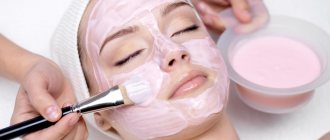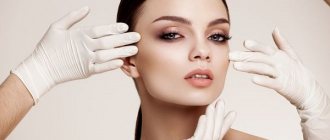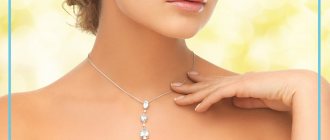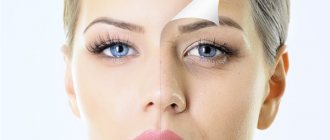PROPERTIES OF PYRUVIC ACID:
- is an important participant in metabolic processes in living organisms;
- normalizes intracellular processes;
- has a sebostatic and depigmenting effect;
- quickly and evenly absorbed by the skin;
- is partially converted into lactic acid on the surface of the epidermis, which prevents drying of the skin.
In addition to pyruvic acid, Red Peel contains a complex of antioxidants. The natural antioxidant complex ROC®, obtained from red Sicilian orange extract, protects the skin from injury, allowing the use of acid in an effective concentration. In addition, antioxidants stimulate neocollagenesis, protect capillary walls from acid damage and have a powerful anti-inflammatory effect.
Thanks to a special gel base and antioxidant complex, in Red Peel peeling pyruvic acid in a high concentration of 50% can penetrate to the papillary dermis layer. Thus, peeling can be either superficial or medium, depending on the patient’s goals.
In the second phase of chemical peeling, an indelible composition containing nanomolecular retinol and hyaluronic acid is applied; this composition accelerates the regeneration processes and forms the thinnest protective film on the face for the most comfortable and safe rehabilitation even after a mid-peel.
After peeling, it is recommended to use a Lift Mask with nanomolecular retinol. This mask enhances the beneficial effects of peeling on the skin, significantly tightens the oval of the face, and relieves even minimal discomfort.
Red peeling
Red Pell or red peeling is called an improved version of pyruvic peel. Completely new technologies were used to create this superficial chemical peel.
Action and composition of peeling
This cosmetic product contains pyruvic acid and a strong antioxidant complex obtained from the extract of Sicilian Blood oranges. This complex is often called ROC, which stands for “Red Orange Complex”. The oranges from which it is made grow near Mount Etna, and therefore have amazing protective properties.
Thus, all the negative effects that pyruvic acid can have (the appearance of age spots, severe peeling) are blocked by the ROC complex. As a result, red peel peeling has only a positive effect on the face.
Also in the section: How effective is almond peeling?
Indications for red peeling:
- scarring;
- wrinkles;
- skin pigmentation disorder;
- decrease in its tone;
- acne.
Features of Red Pell peeling
Red peeling is carried out in two stages:
1. First, a mixture of ROC and pyruvic acid is applied. The solution is left for a period of 1 to 10 minutes, depending on the skin type and problems present. After which the mixture is washed off with ordinary water.
2. Then a drug containing retinol in microcapsules is applied. This is a new technology in the world of peeling. Previously, it was used only in the manufacture of medicines. Although the presence of such small capsules allows retinol to act for a longer time.
The preparation for phase 2 also contains hyaluronic acid. It forms a thin film on the face that protects it from the effects of the external environment and at the same time makes the procedure itself more comfortable.
The product used for the 2nd phase is not washed off. This allows it to fully penetrate the skin and realize its functions.
Effect
The main advantage of red peeling is the protection of the skin from negative influences. After a course of procedures, the face acquires a healthy color, is moisturized, toned, and pimples and wrinkles quickly disappear. At the same time, there is no severe peeling, redness and other “joys” inherent in conventional peelings.
The course will be especially useful for those who want to radically rejuvenate. If after the first session the effect of retinol may not be very noticeable, then after a series of procedures the face is simply transformed, and those around them never cease to be amazed at the changes that have occurred.
INDICATIONS FOR RED PEEL CHEMICAL PEELING
- signs of photoaging;
- wrinkles of medium depth;
- hyperpigmentation;
- ptosis, unclear oval face;
- comedones, acne, post-acne, enlarged pores.
The peeling effect is obvious after the first procedure, and after a course of 3-5 procedures with an interval of 10-15 days, the result exceeds your wildest expectations and lasts for a long time. The rehabilitation period after peeling lasts only a few days and is quite easy and comfortable, without severe hyperemia and excessive peeling.
If you notice signs of photoaging, age spots, comedones, acne marks or other skin imperfections, sign up for a consultation at the Clinic of German Medical Technologies and find out if the innovative two-phase chemical peeling RED PEEL procedure is right for you.
Acid peeling
Modern cosmetology offers many methods of cleansing and restoring the natural beauty of the face, which include acid peels.
What it is?
Peeling with acids is a procedure for cleansing and renewing facial skin, the essence of which is the process of removing dead epidermal cells with subsequent renewal of the skin.
Organic acids are used as the main active components of the peeling mixture: glycolic, lactic, salicylic, etc.
Procedure Objectives
The main objectives of chemical peeling include:
- removal of keratinized epidermal cells;
- elimination of aesthetic imperfections: wrinkles, hyperpigmentation, scars, post-acne.
- stimulating the body's defense response;
- production of new portions of collagen and elastin.
Mechanism of action
Under the influence of chemical acids, the compounds of the horny scales of the layers of the epidermis are destroyed, which is accompanied by their subsequent exfoliation from the skin. As a result of active cleansing of dead cells, the process of removing contents from the sebaceous glands is accelerated.
The acids used in peeling preparations simultaneously affect living cells. This, in turn, activates regeneration processes and subsequent renewal of the skin by accelerating the synthesis of natural building proteins - collagen and elastin, as well as hyaluronic acid.
For which zones does it apply?
Chemical peeling is usually used on the face, but it can also be used on the neck, décolleté, and hands.
Alkaline peeling is effective for any skin type, it can also be used regardless of age. The main difference will be the choice of the main component - the acid and its degree of concentration.
Types of chemical peeling
So, you already know what acid peeling is. Let's look at what types of peelings there are and how they differ.
Types of peeling by depth of influence
In cosmetology, chemical peels are classified according to the depth of impact on:
- superficial;
- median (average);
- deep.
Superficial peeling
It acts on the upper layers of the skin and, with proper post-peeling care, does not require a long recovery period.
This is a gentle type of chemical treatment. It is considered the safest because... the concentration of chemical acid in peeling preparations does not exceed 20%. It is used to improve skin color, restore freshness and velvety.
Medium (medium) peeling
It affects the layers of the epidermis without affecting the basement membrane. What does this peeling do? It effectively eliminates shallow wrinkles, post-acne and other aesthetic skin imperfections, and also fights age-related changes.
The procedure is more painful compared to superficial peeling, since acids of 30-40% concentration are used to treat the skin, which, in turn, affects the degree of skin damage and the recovery period. After such peeling, redness, swelling, and severe peeling appear on the face, and therefore the rehabilitation period increases to 7 days.
Deep peeling
The active component of the peeling mixture for the procedure is phenol, which creates a chemical burn on the skin, thereby removing the layers of the epidermis to the dermis.
The most traumatic way to renew the skin and eliminate visible aesthetic defects. This type of peeling is performed in a hospital setting using anesthesia.
After such a chemical burn, the skin begins to completely renew itself and, as a result, becomes absolutely clean and smooth like a baby’s.
Deep chemical peeling is carried out in adulthood - from 60 years and older.
Table 1. Types of peeling by depth of impact
| Peeling | Which layers of skin are affected? | What acids are used | Acid concentration, % | What problems does it solve? |
| Surface | Upper layers of the epidermis |
| 10-20 |
|
| Middle | Stratum corneum of the epidermis to the basement membrane |
| 30-40 |
|
| Deep | Inner layer of epidermis down to papillary dermis |
| 35-40 |
|
Types of peeling by composition
Acid peels differ in composition and the main active ingredients used – chemical acids. There are glycolic, retinoic, salicylic, almond and other types of peeling.
Table 2. Types of peeling by composition
| Peeling | Acid | Skin type | Number of procedures | What problems does it solve? |
| Glycolic peeling | Glycolic | All types | 4-10 |
|
| Yellow peeling | Retinoic | Fat Problematic Mature (35-50 years old) | 3-5 |
|
| Hollywood peeling (Jessner) | Salicylic Dairy | Fat Fading | 5-6 |
|
| Salicylic peeling | Salicylic | Fat Problematic Mature with signs of photo- and bioaging | 5-7 |
|
| Almond | Almond (phenoxyglycol) | Fat Combined Porous Mature | 6-8 |
|
| Trichloroacetic peeling | Trichloroacetic (TCA) | Fat Porous Mature |
| |
| Fruit | Fruit:
| Problematic Normal With the first signs of aging | 7-11 |
|
| Lactic | Dairy | Dry (up to 30 years) Prone to allergies | 3-6 |
|
Facial peeling with glycolic acid is considered a superficial type of chemical peel. It effectively renews the upper layer of the epidermis without affecting the deeper layers of the skin. It is used for all skin types, the only restriction is age under 15 years. More details about glycolic peeling can be found in the “Acid Peels” section.
Retinoic (yellow) peeling is a peeling with retinoic acid, which in color resembles a ripe yellow lemon. It is a gentle drug; at the same time, the effect of acid is comparable to some medium peels.
The Jessner peel is considered a relatively gentle chemical peel based on a combination of three chemical components: salicylic acid, lactic acid and risorcinol. It can be used as a superficial and medium peeling. The difference lies in the number of layers of peeling composition applied to the skin.
The basis of salicylic peeling is salicylic acid, which acts as a powerful antiseptic. It cleanses the skin well, tightens pores and restores the functioning of sebaceous ducts.
Almond peeling is a gentle chemical treatment of the skin with mandelic acid. This peeling falls into the category of effective ways to combat acne, post-acne, excessive oily skin, and enlarged pores.
The mixture for trichloroacetic peeling includes the acid of the same name (TCA acid), which dissolves in water and has a pronounced cauterizing property. Depending on its concentration, such peeling can be superficial, medium or deep.
Fruit peeling is called atraumatic facial cleansing, since fruit acids are used as the main component of the peeling mixture. These acids gently act on the upper and middle layers of the epidermis, cleansing, smoothing and whitening the skin of the face.
Lactic acid peeling is a superficial peeling. It has a gentle effect on the skin and does not cause redness or swelling of the skin. This peeling can be recommended as an anti-acne peeling for those for whom other types of peeling are contraindicated.
As a rule, when choosing a chemical peel, a lot of questions arise: what kind of procedure is it; what are its pros and cons; is it painful to do; such peeling will be beneficial or harmful; Is it possible to do peeling around the eyes, etc. Before making a decision, it is important to consult your cosmetologist.
Experts will explain in detail how and how acid peels are made, how dangerous this or that type of peeling can be, how often peeling can be done and will help you decide which peel to choose, how many procedures you need to carry out to get the desired result.
Remember! Peeling should be carried out only in stationary conditions, and the rehabilitation regime and all recovery procedures must be strictly observed! Only in this case there will be no negative consequences, and the effect will be 100%!
Indications and contraindications
Chemical peels are recommended for use in autumn and winter, due to the fact that in summer ultraviolet rays are overly active and their effect on peeled skin has negative consequences.
General indications for acid peels
- photoaging;
- acne;
- post-acne;
- acne;
- black dots;
- fading, loose skin;
- enlarged pores;
- fine wrinkles;
- dark spots;
- keratomas;
- scarring;
- scars;
- hyperpigmentation;
- papillomas.
In addition to the main indications, acid peels are prescribed in complex therapy for severe acne, xeroderma (excessive dry skin), and ichthyosis.
After acid peeling, it is allowed to carry out procedures of biorevitalization, mesotherapy, botulinum therapy, plasma lifting, and contouring.
General medical contraindications for acid peels
- herpes;
- viral warts;
- pustular rashes;
- acute acne;
- eczema;
- psoriasis;
- atopic dermatitis;
- injuries and wounds on the skin;
- individual intolerance to acids;
- oncology;
- cardiac, renal, liver failure.
- dark and dark skin types IV–VI.
Temporary contraindications include facial hair removal, which can be performed at least 7 days before chemical peeling, as well as mechanical and laser dermabrasion. These procedures cannot be completed no less than six months in advance.
Acid peels are prohibited for severe rosacea. At the initial stage of rosacea, gentle superficial types of peeling are allowed, in which acids with a minimum concentration are used.
During pregnancy and breastfeeding, the possibility of performing the procedure is determined by the doctor. In the absence of strict contraindications, gentle peelings are permitted.
If you have a tattoo on the contours of your lips and eyes, acid peeling should be used with caution, since during treatment with aggressive acids, for example, trichloroacetic acid, the design may lighten.
To speed up the recovery process after peeling and get a prolonged effect, it is recommended to give up alcohol, hot and spicy foods.
Let us remind you that each type of peeling has its own characteristics, which include the recovery period and possible complications. Only a qualified specialist will determine exactly which type of chemical peeling will be the most optimal in a particular case, how many times you need to visit a cosmetologist to complete the entire course and how often to do similar courses.
At what age can it be done?
Each type of acid peeling has its own age restrictions. Peels for problematic young and oily skin can be performed starting from the age of 15. Rejuvenating superficial and medium peels can be done starting from the age of 25, deep peels are used in adulthood.
How the procedure works - general steps for all types of peelings
The protocol for each type of acid peeling, as a rule, differs in two or three points, however, the general algorithm of actions includes the following steps:
- pre-peeling preparation;
- peeling;
- final stage.
Pre-peeling preparation
This stage involves skin care using special products selected by a cosmetologist. This helps prepare the skin to be more effectively exposed to acids. You should start preparing one to two weeks before the procedure.
Peeling
The procedure includes direct treatment with peeling preparations. The cosmetologist first cleanses the skin of makeup and street dirt. Then he applies the mixture to the face in a certain sequence, monitoring the reaction of the skin. The mixture is kept for a certain time, after which the specialist applies a post-peeling preparation to the skin, which neutralizes the acid, moisturizes and soothes the skin.
Final stage
Upon completion of the procedure, a special composition is applied to the facial skin, which accelerates the regeneration of the cells of the procedure.
The specialist then gives detailed instructions regarding post-peel care and determines when the next procedure can be done.
Precautionary measures
During the procedure, the specialist must follow certain precautions that help avoid complications in the post-peeling period. In particular, if severe redness appears on the skin during the procedure, he immediately weakens the effect of the acid with a special composition. The specialist keeps the peeling mixture applied to the face for a strictly defined time, since overexposure to it can lead to swelling and the appearance of pigmented spots.
At what intervals are procedures performed?
As a rule, a course of light superficial peelings includes 4-10 procedures performed every 7-10 days. The average peeling course is 5-6 procedures every 25-30 days. One course is held once a year. One deep peeling procedure lasts for several years.
General rules for post-peeling care
Feelings in the first days after peeling
After the procedure, there is a feeling of tight skin on the face, swelling and moderate redness are observed, which, with the right approach to the procedure, disappear within a week. Peeling occurs on the second or third day.
After what peelings should your face peel off, but after these peels – not?
The skin may not peel off after the first superficial peeling. This means that the top layer of skin was removed along with the remnants of the peeling mixture at the final stage of the procedure. In this case, peeling will appear after several procedures.
Medium and deep peels, as a rule, are always accompanied by pronounced and prolonged exfoliation.
How long does it take for the face to heal after the procedure?
After a soft, superficial peeling, the skin usually recovers within 2-3 days; after a medium peel, within 7 days. The skin recovers after deep peeling within 4 weeks.
What to do after the procedure
Post-peeling care involves intensively moisturizing the skin and restoring the epidermis. As a rule, for intensive hydration, preparations are used that contain hyaluronic acid, alginates, and amino acids. Panthenol and retinol promote rapid healing and cell regeneration.
What not to do
You should not wash your face after the procedure for 12 hours, and in the first days you should not use decorative cosmetics or scrubs. Under no circumstances should you steam your face or use homemade masks. For 2 or even 3 months you should avoid tanning in the solarium, visiting the sauna, bathhouse, and swimming pool.
Possible complications
If the procedure is performed incorrectly, side effects and complications often occur.
What complications may arise?
- skin irritation and hyperemia,
- pronounced swelling.
- too deep, chemical burn;
- hypo - or perpigmentation;
- persistent redness;
- rosacea;
- scarring.
In any of these cases, you should definitely consult a specialist. He will recommend what to apply to the face for redness and swelling, and what pharmaceutical preparations to use to eliminate hyperpigmentation and rosacea. As a rule, such undesirable consequences quickly disappear if all recommendations regarding post-peeling care are followed.
What general safety rules should you follow?
As noted above, chemical peels make the skin sensitive to UV rays, which can cause unwanted pigmentation. In this regard, experts recommend covering your face with sunscreen after the procedure.
During the first week, you should not use scrubs and cosmetics containing alcohol. Preference should be given to cleansers based on plant extracts.
Alternative procedures
If for some reason acid peeling is not possible or rapid skin renewal is required, cosmetology offers alternative methods of facial cleansing.
Laser resurfacing
Laser skin resurfacing is the treatment of the skin with a laser beam, which quickly and without injury cleanses the facial skin of dead epidermal cells. This cosmetic procedure smoothes wrinkles, removes acne, pigmentation, and evens out skin texture. After laser treatment, the skin recovers within 7 days.
Microdermabrasion
Diamond peeling also serves as an alternative to acid peels. It is a process of grinding the upper layers of the skin by spraying tiny mineral crystals onto its surface. It is used to quickly cleanse the top layer of skin, effectively smooth out wrinkles and scars.
Face cleaning
You can renew your skin using mechanical facial cleansing; moreover, this method allows you to simultaneously cleanse dirty pores. This procedure does not require a long period of rehabilitation, since the restoration of the epidermis occurs in the shortest possible time.
So, chemical (acid) peeling renews cells, improves blood circulation, and returns elasticity and firmness to the facial skin. However, like other cosmetic procedures, it has pros and cons.
Pros of acid peeling:
- cleansing the skin of the stratum corneum of the epidermis;
- correction of age-related changes;
- non-surgical skin rejuvenation.
Disadvantages of chemical peeling:
- risk of complications;
- painful procedure;
- long period of rehabilitation.
The advantages of chemical peeling are obvious and include effective rejuvenation of facial skin without surgical intervention. However, this is to a certain extent a radical procedure that should be performed exclusively in a professional setting in compliance with all rules and precautions.
Where to make it, how much does it cost?
If, after reading our article, you decide to sign up for an acid peeling procedure with a professional, just use our directory, it contains cosmetologists and clinics in all cities of Ukraine:
Vinnitsa, Dnepr, Zhytomyr, Zaporozhye, Ivano-Frankivsk, Kiev, Krivoy Rog, Kropyvnytskyi, Lutsk, Lviv, Mariupol, Nikolaev, Odessa, Poltava, Rivne, Sumy, Ternopil, Uzhgorod, Kharkov, Kherson, Khmelnitsky, Cherkasy, Chernihiv, Chernivtsi .
Choose a specialist
Kravtsova Irina
Chief physician, candidate of medical sciences, cosmetologist, dermatovenerologist
Read moreMake an appointment
Varvaricheva Olga
Candidate of Medical Sciences, cosmetologist, dermatovenerologist
Read moreMake an appointment
Tyutcheva Daria
Candidate of Medical Sciences, cosmetologist, dermatovenerologist, trichologist
Read moreMake an appointment
Karausheva Tatyana
Cosmetologist, dermatovenerologist
Read moreMake an appointment
Pleshkova Anna
Cosmetologist, dermatovenerologist
Read moreMake an appointment
Markina Natalia
Cosmetologist, dermatovenerologist
Read moreMake an appointment
Kulakova Irina
Cosmetologist, dermatovenerologist, trichologist
Read moreMake an appointment
Tokhirova Mavjuda
Cosmetologist, dermatovenerologist
Read moreMake an appointment
Rudyka Natalia
Cosmetologist, dermatovenerologist
Read moreMake an appointment
Registration online
For your convenience, we offer to fill out a health questionnaire remotely. By the time you arrive, the file will have already been printed and all you have to do is sign it.
Also on the page with the questionnaire you can familiarize yourself with the contract for the provision of services and other documents that will need to be signed during your visit to the clinic. This will reduce the time spent familiarizing yourself with and filling out documents at the clinic.
Fill out documents online
Special offers











